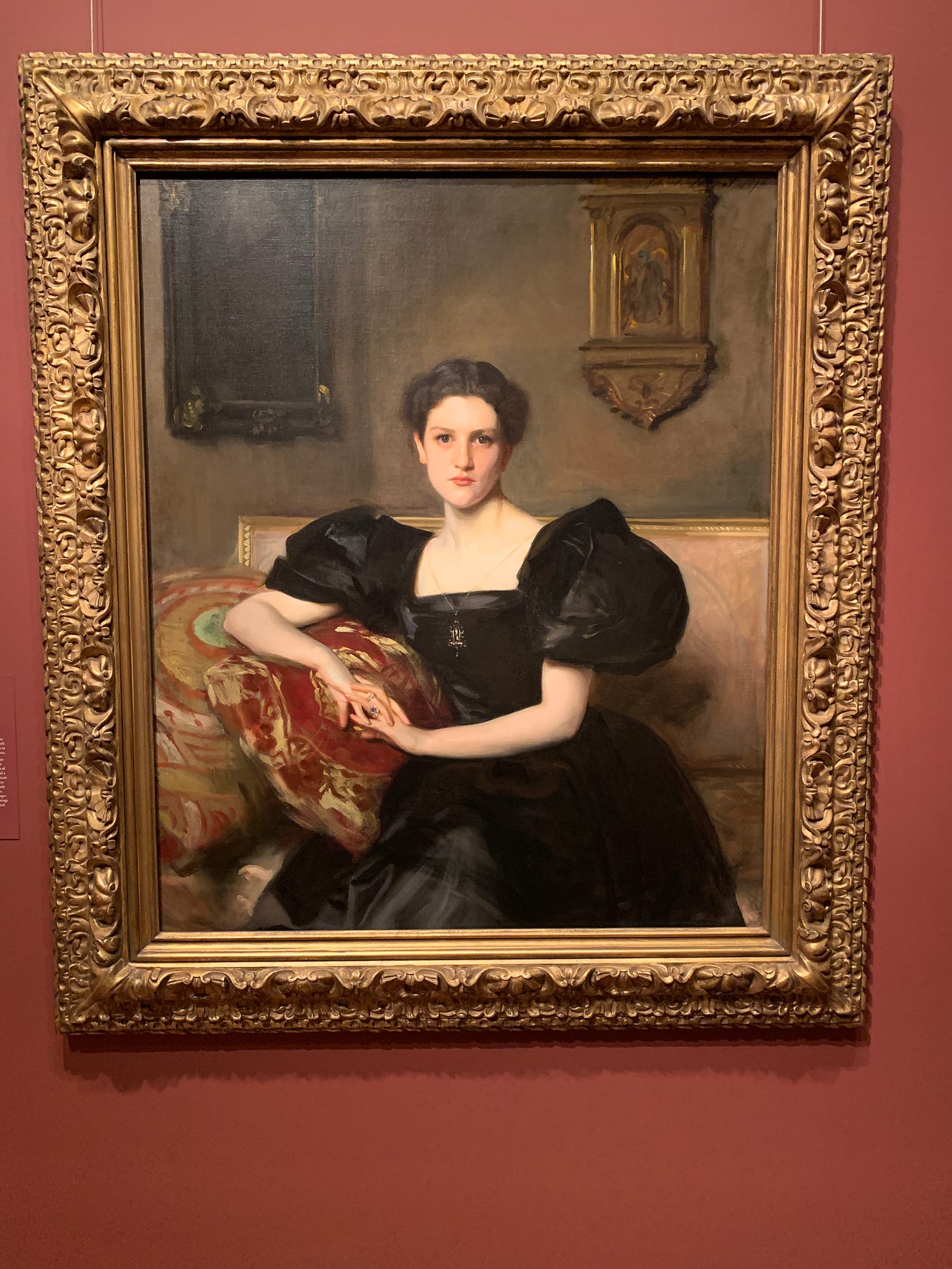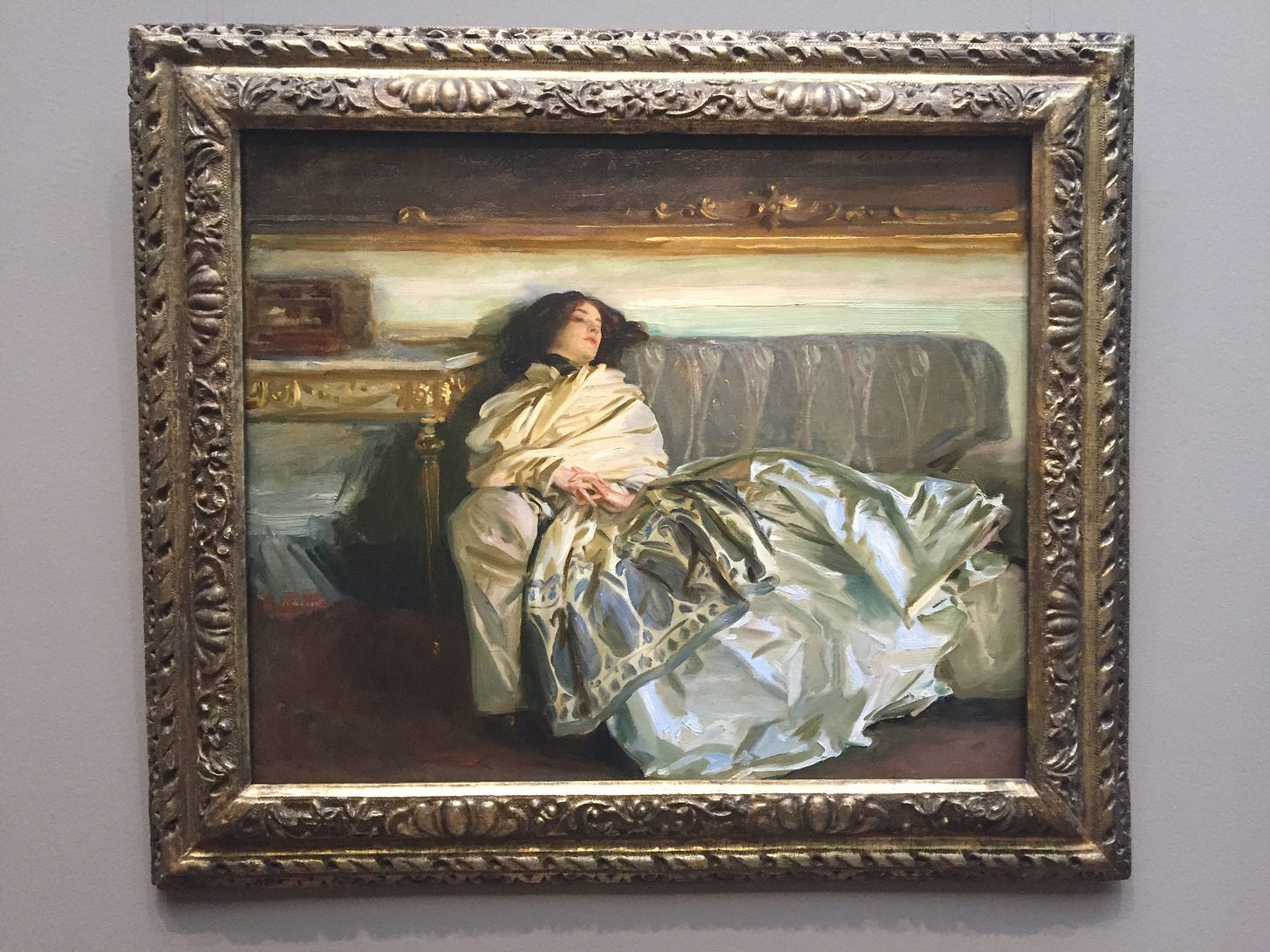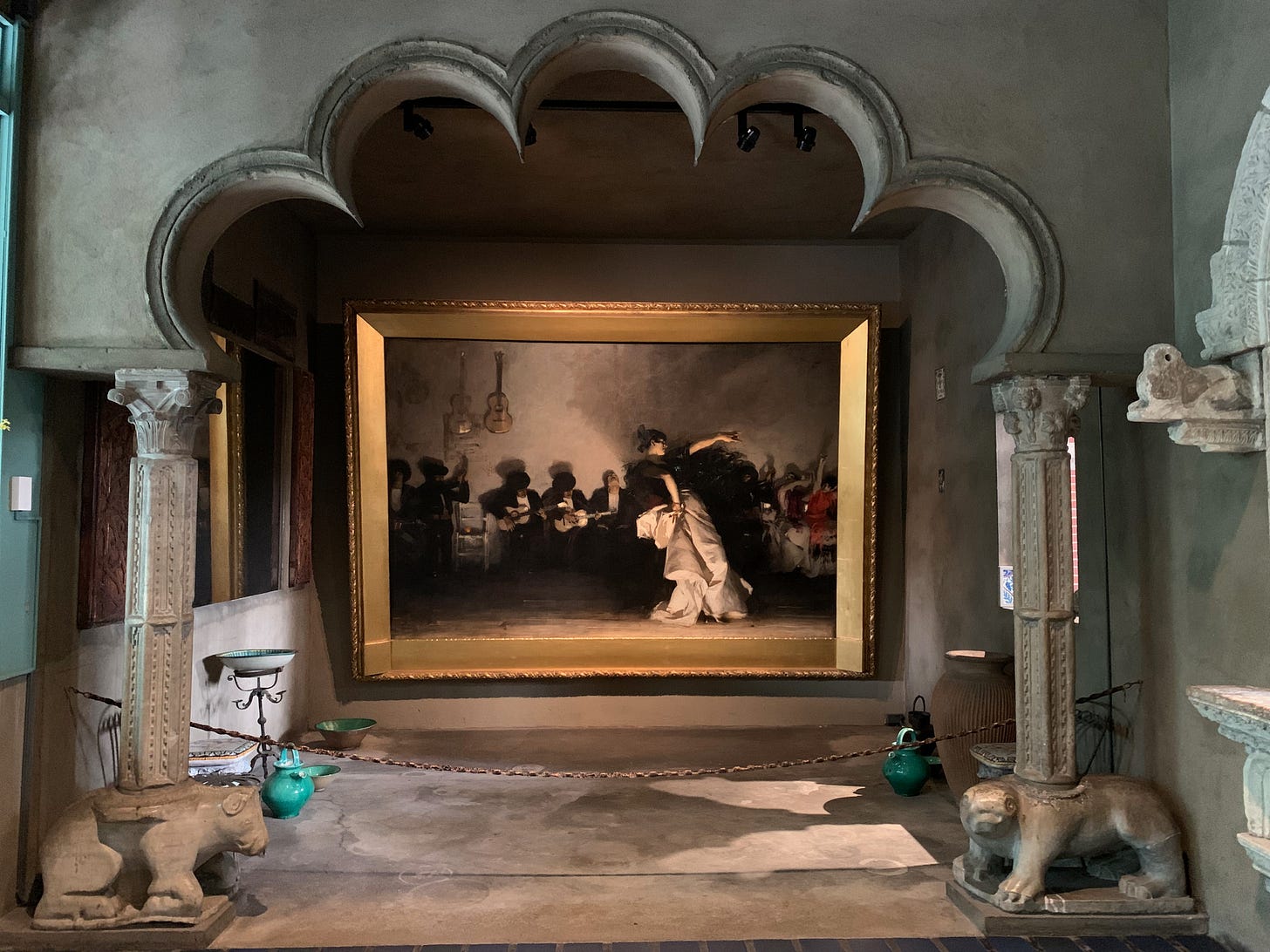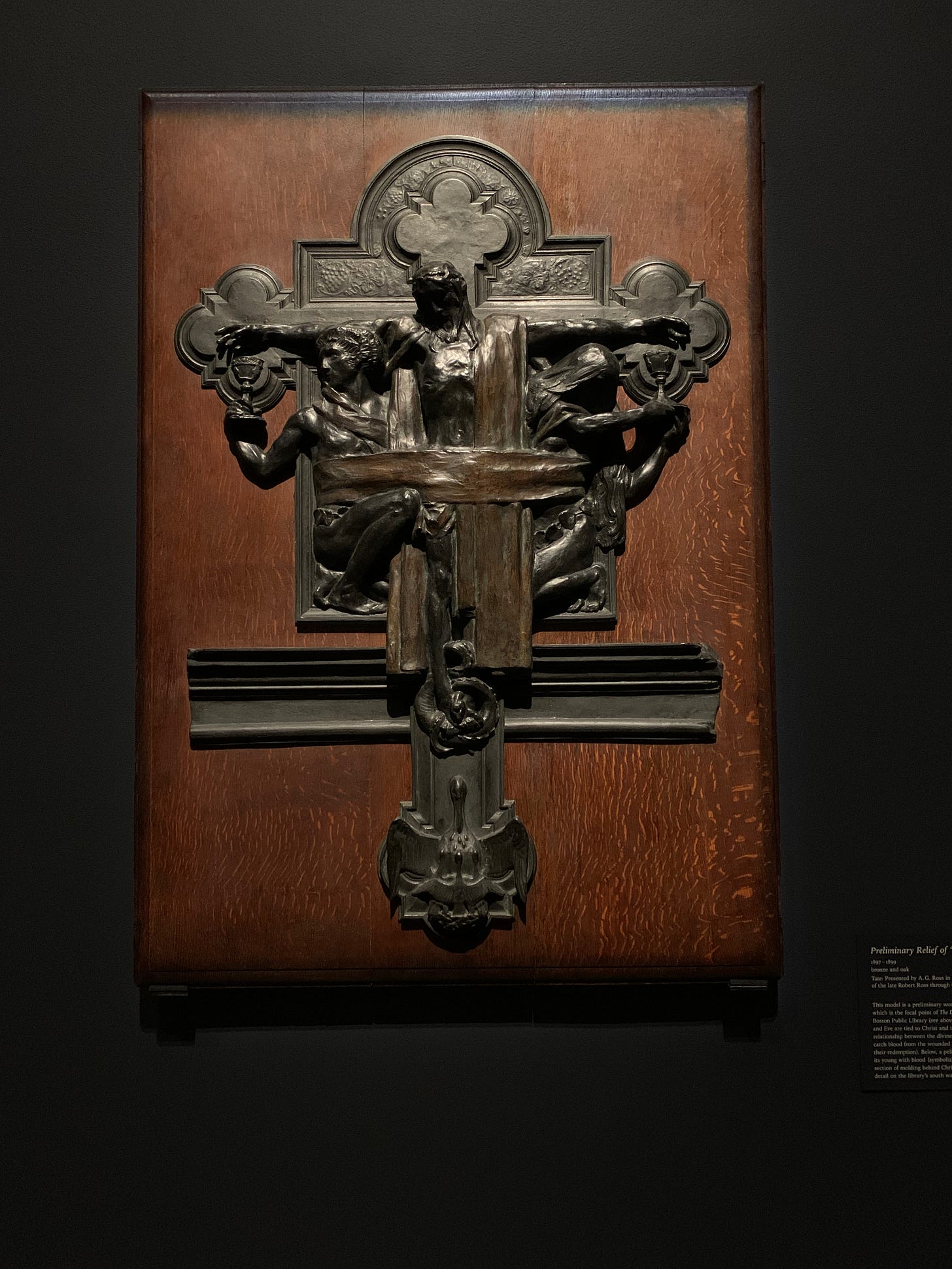The Disappearing Dancer
On John Singer Sargent’s enigmatic women and what happens when we take our friends for granted.
John Singer Sargent largely is known for “Madame X,” his larger-than-life portrait of a woman whose off-the-shoulder black dress scandalized the art world, but it was a different Sargent woman who first captivated me—Elizabeth Winthrop Chanler. Once said to have “the face of the Madonna and the eyes of the child,” the heiress and congressman’s daughter posed for Sargent in 1893, at age 26, and the painting hangs in the Smithsonian American Art Museum (SAAM) next to her christening silver.
Working a couple blocks from the museum, I often spent my lunch hours there, and I came back to Chanler a lot. A bench sits in front of the painting, inviting you to rest and take it in. Her gaze is direct; her dark eyes look like they are seeing into your soul. There’s something off-putting about her portrait; she looks serene at first glance, but there's tension in her bearing. Her hands are clasped tightly on a pillow in front of her.
In 2017, I attended a book talk at the museum by Donna Lucey, who wrote “Sargent’s Women: Four Lives Behind the Canvas.” This book profiled four of Sargent’s subjects, including Chanler, and hinted at the source of the portrait’s tension. Lucey spoke about the socialite’s turbulent childhood, spent caring for seven younger siblings after her mother’s death. After developing a hip disease as a teenager, Chanler spent two years strapped to a board to prevent curvature of the spine. She later befriended a woman named Minna Timmins Chapman and fell in love with her tempestuous husband, John Jay Chapman.
Chapman was a fiery man—literally. When a college rival insulted Timmins, Chapman beat him up, and, to atone for his sins, stuck his arm in a fire and burnt it so badly his hand had to be amputated. He and Chanler began an affair, Chanler’s sisters found out and whisked her off to India, and Timmons eventually died after childbirth complications. During Chapman's mandatory two-year mourning period, Chanler and he arranged secret meetings, including one on an abandoned island. While Chanler was pregnant, Chapman had a nervous and physical breakdown, leaving her to care for him, his three children from his previous marriage, and her baby alone. What a life! No wonder she looked a little tired, a little steely-eyed, a little like she was girding her loins in the portrait.
I came back to visit that painting a lot. I also found a friend in “Nonchaloir (Repose),” a 1911 oil painting down the road at the National Gallery of Art. Painted after Sargent grew disgruntled with traditional portraiture, “Repose” depicts his niece, Rose-Marie Ormond, lounging on the couch, in stark contrast to Chanler’s rigid pose. I spent many lunch hours resting in its presence, wishing that I could feel as relaxed, as calm, as luxurious as Rose-Marie looked, and delighting in the absolute splendor of her skirt’s luminous folds.
I liked Sargent's women in action, too. In an alcove in the SAAM, I’d linger at his large “Study for El Jaleo,” a preparatory work for a larger painting of a Spanish Romani dancer, and marvel how he got her arms to look like that—her left arm outstretched, her right on her hip, how he captured the folds of her skirt and fringe of her shawl, and how the shadows fell on her face. I considered this painting, tucked in an alcove on the second floor, a loyal friend that would always be there—until, one day, it wasn’t.
I figured it would come back; paintings cycled in and out of rotation all the time. Maybe conservators were working on it—the Lunder Conservation Center, which lets visitors peek through glass windows at the conservation process in action, is a highlight of the museum. But no, months and then years passed, and my friend never came back.
Her whereabouts haunted me. I once asked someone working at the gallery, and she had no answer. Nothing came up on the online catalog. Though I swore I had taken a photo of the painting, I couldn’t find one. I began to doubt she had existed at all, until I found a few references to the painting on personal blogs and Flickr accounts. As far as I can tell from some attempts at research, the painting is part of a private collection; perhaps it had been on loan. I vowed to visit the full “El Jaleo” at the Isabella Stewart Gardner Museum someday.
Sargent came back into my life in a big way in 2022, when I returned to the office part-time after working remotely during the COVID-19 pandemic, and resumed more regular museum visits. First, in April, I saw the SAAM exhibit “Sargent, Whistler, and Venetian Glass: American Artists and the Magic of Murano,” which focused on how the Venetian glass revival of the late 19th century inspired artists. Unfamiliar with the Venetian glass revival, I found myself intrigued by the moments of quiet intimacy Sargent, Whistler, and other featured artists captured in what seems like such a grand city.
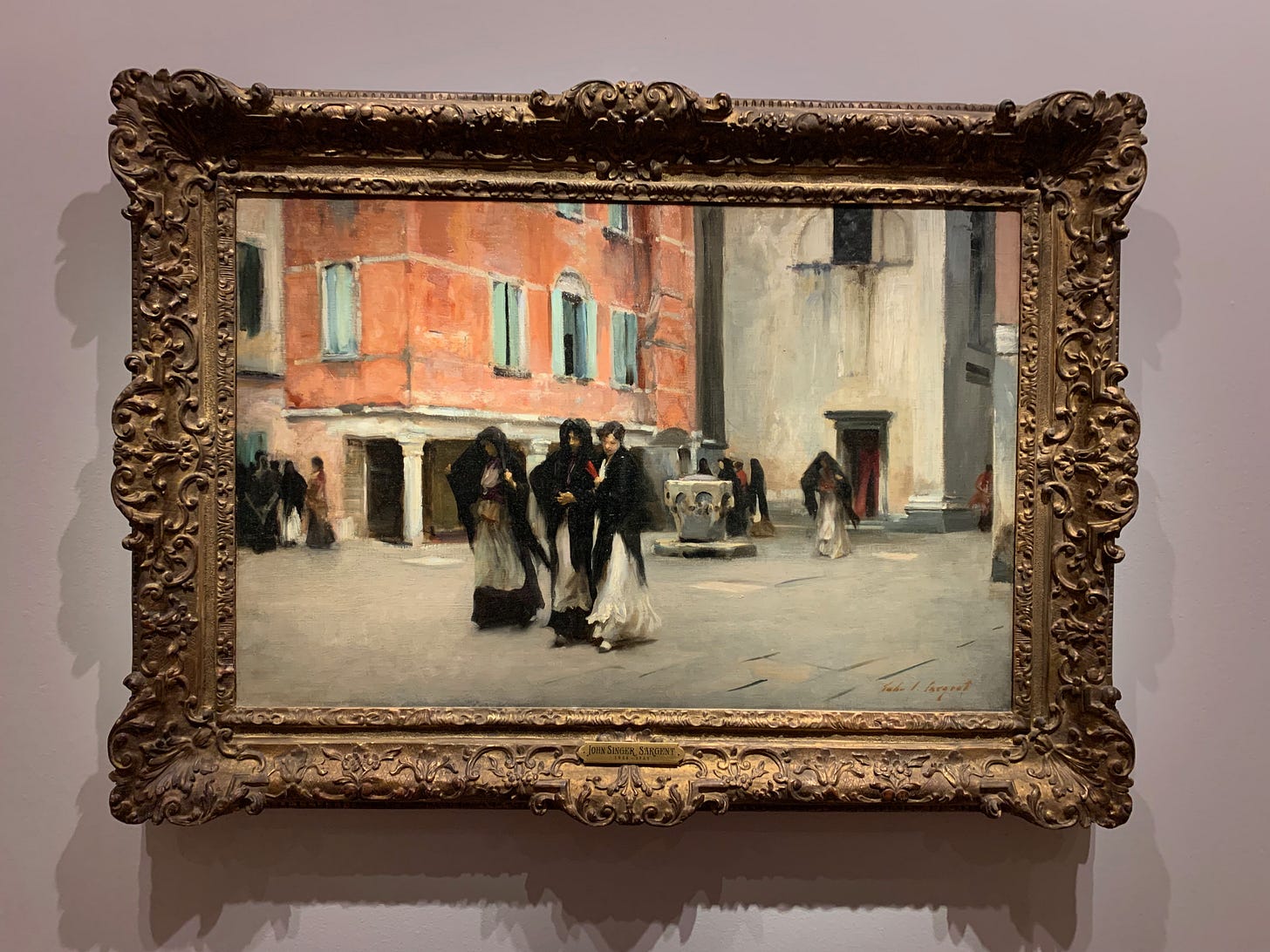
I continued my Sargent journey in June, when I traveled to Boston for work and decided to spend some additional time exploring the city on my own. Sargent is ubiquitous in Boston; he held his first solo exhibition there. I first encountered my friend through his murals in the Boston Public Library, and found him again in the Museum of Fine Arts Boston, an absolutely colossal building featuring gorgeous Beaux-Arts Sargent murals in its rotunda and grand staircase.
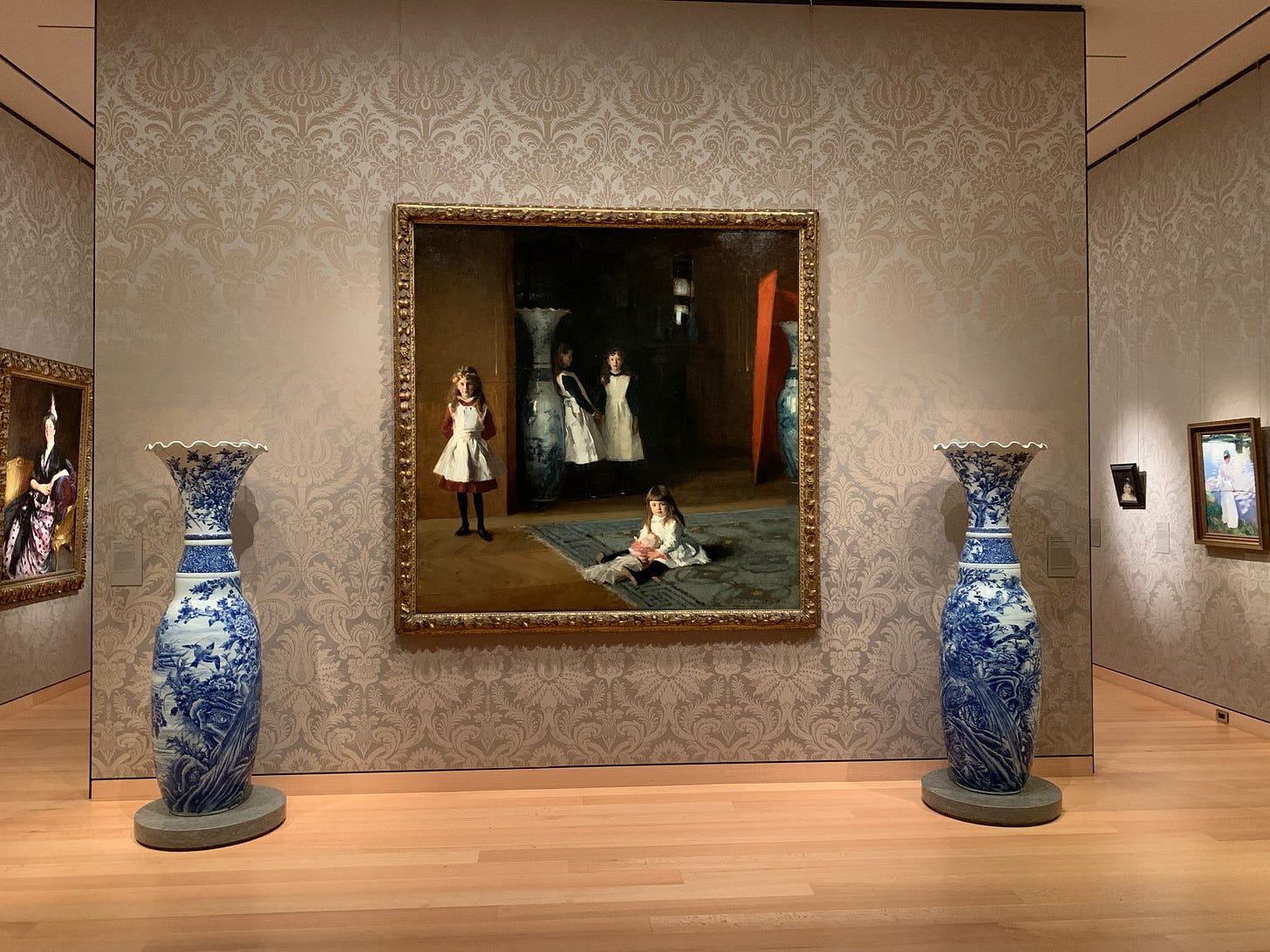
And, the next day, I saw her: the Spanish dancer in “El Jaleo,” displayed in the Spanish cloister at the Isabella Stewart Gardner Museum. This place is an incredible and somewhat mysterious treasure trove. Gardner stipulated that the museum be left exactly as she left it and no works be moved or loaned, so this is the only place you could ever see the painting. In 1990, the museum was burgled in the single largest property theft in the world—13 pieces of art were stolen from Gardner’s carefully curated museum, and the case is still unsolved, lending a sense of intrigue to the space. Gardner and Sargent were close friends, and several of his paintings appear in the museum, including portraits of Gardner herself.
“El Jaleo” is one of the first paintings you see, flanked by a Moorish arch Gardner built specifically for the painting before she even acquired it. It was more massive than I had expected, inviting you into the scene. Here, the dancer is not alone but surrounded by a group of musicians, the light gleaming off their guitars, and a couple other brightly costumed women in the corner. One man has his head back against the wall, his mouth open. An empty chair invites you to sit down. You can practically hear the painting singing.
My friend and I were together again.
Finally, in the fall, I rounded out my year of Sargent with an exhibit at the National Gallery of Art focused on Sargent and Spain, which chronicled the painter’s fascination with the country and aimed to give voice to the Romani people he depicted. Seeing the studies for the cross hanging as part of his “Triumph of Religion” mural was especially moving; they filled me with a surprising reverence, a sense of awe that almost sent me to my knees before the crucifix. The exhibit also featured studies for the Spanish dancer and many other paintings of Romani dancers. Seeing the full scope of Sargent’s process made me feel even more connected to the artist.
The whole thing reminded me of a movie I’d seen on TV years ago, “The Maiden Heist,” which features Morgan Freeman, Christopher Walken, and William H. Macy as security guards who grow to love the art they guard. When they learn some of their beloved artworks will be transferred to another museum, the guards unite to replace the art with copies and steal the originals for themselves. It’s a goofy film that went straight to DVD, but it stayed with me; I manage to think about it every time I visit a museum. If I were in their shoes, I would have been sad to lose my friends, too. (Maybe I need to be careful talking about heists. I’m already sus after the Monet incident.)
All this to say, I don’t take my remaining Sargent friends for granted. I make it a point to visit Elizabeth Winthrop Chanler every time I visit the SAAM, and I take a picture of her. Even if I’ve taken one before, something different—the glint of her lips, the tension of her hands, the sorrow in her eyes—always grabs me, and I want to appreciate the painting in every light I can. I’m so grateful for my encounters with Sargent, a master of capturing intimacy and immediacy, and the ability to call him and his works friends.




